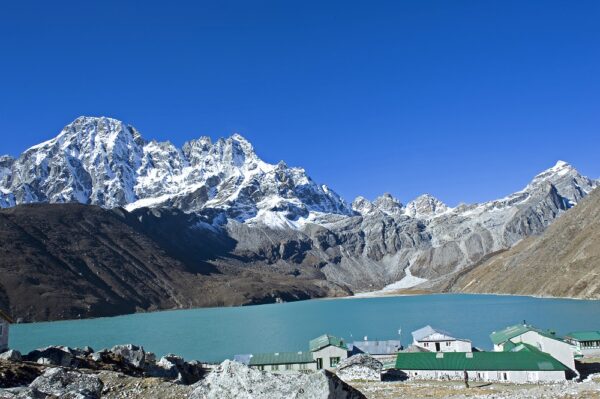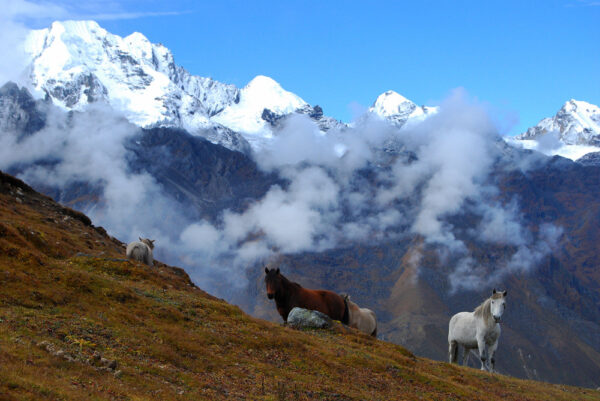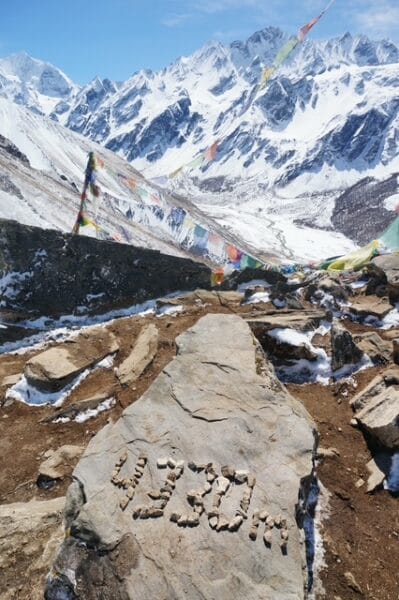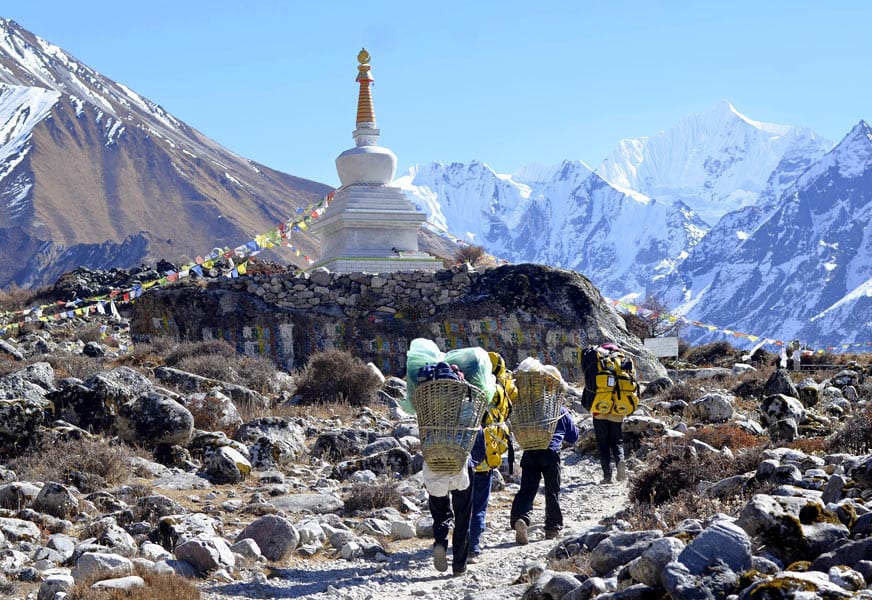
-
trip code
TGN-37
-
difficulty
Moderate
-
Trip Style
Group
-
Start in
Kathmandu
-
end in
Kathmandu
-
group size
2 - 14 Pax
-
max altitude
3870m
-
Accommodation
Hotel, Tea house
-
Best Season
September, October, November and December and March, April and May.
Overview
Table of Contents
ToggleLangtang Kyanjin Gompa Trek: Explore the Heart of Langtang Valley
The Langtang Kyanjin Gompa Trek is a breathtaking adventure through Langtang National Park, just an hour and a half’s drive from Kathmandu. This 10-day trek offers stunning views of snow-capped peaks, peaceful forests, and traditional Tibetan villages. Along the way, you’ll visit the sacred Kyanjin Gompa Monastery and immerse yourself in the rich culture of the Tamang people.
Unlike crowded trails in regions like Everest or Annapurna, this trek provides a quiet and intimate trekking experience, making it perfect for those seeking serenity in the Himalayas.
Why Choose the Langtang Kyanjin Gompa Trek?
This trek stands out for its peaceful atmosphere and cultural richness. Along the trail, you will cross high mountain passes, explore dramatic glacial valleys, and witness Tibetan Buddhist traditions firsthand. It offers a unique balance of natural beauty and cultural insight.
The best time to embark on this journey is during spring (March to May) and autumn (September to November), when the skies are clear and mountain views are at their best.
What to Pack for Your Trek
Be sure to bring warm clothing and a down jacket for cold mountain conditions. Comfortable trekking boots, sunglasses, and high-altitude sunscreen are essential. Don’t forget a first-aid kit and any personal medications. Carry a reusable water bottle with purification tablets to stay hydrated safely.
Trekking Tips for a Safe Experience
Drink plenty of water to prevent altitude sickness, and allow time to acclimate properly, especially in Kyanjin Gompa. Respect local customs and traditions by engaging with the Tamang community thoughtfully.
Highlights Along the Trail
The trek also offers visits to ancient monasteries and chances to sample local cuisine. Wildlife lovers might spot rare animals such as red pandas or Himalayan black bears, adding excitement to the journey.
If you’re interested in exploring more treks in Nepal, check out our Everest Base Camp Trek guide or discover the scenic Annapurna Circuit Trek.
For more information about the region, visit the official Langtang National Park page by UNESCO.
This trek blends culture, adventure, and peace, offering a memorable Himalayan experience close to Kathmandu. Whether you’re a seasoned trekker or new to the mountains, it promises an unforgettable journey.
Trip highlights
- Sacred Tamang culture permeates through every inch in this uniquely cultural expedition.
- “Off-the-beaten-path” hiking experience.
- High chance of encountering Grey Langur Monkey troops in the rhododendron forest of Thaman.
- Quaint villages of Briddim and Gatlang.
- Italian coffee at a height of 3,870m at Kyanjin Gompa.
- A chance to spot the endangered Red Panda, Himalayan Black Bear and the elusive Snow Leopard.
- Yak pastures and yak cheese factories at Langtang Village.
itinerary
-
day 01
Arrival in Kathmandu.
- Arrive at Tribhuvan International Airport in Kathmandu.
- Nepal Tour Guide team will greet you and drop you at your hotel.
- Half day visit of major world heritage sites in Kathmandu such as Royal Kathmandu Durbar Square, Pashupatinath temple, Syambhunath, and Boudhanath stupa.
- Prepping for the next day’s trek.
- Overnight stay at your hotel.
-
day 02
Kathmandu (1400m) – Syabrubesi (1460 m), 8 hours drive
- After morning breakfast, you travel via a bus through Trishuli Bazaar, and then Dhunche to Syabrubesi.
- Although roads are bumpy and rough, the travel becomes so pleasurable with sights of beautiful landscapes and snow-covered mountains.
- You stay at a lodge in Syabrubesi. Make sure you sleep on time as your body is tired of long and enduring bus ride.
-
day 03
Syabrubesi (1460m) – Lama Hotel (2420m), 6 hours trek, 7 miles
- As the trek begins, you pass through Bhote Koshi River and follow Langtang River.
- After passing through a suspension bridge, you have to walk through Pahiro to reach to Bamboo. The trail then crosses a subtropical forest. Red Panda, Langur monkey, wild boars and various birds inhabit the forest.
- The trail then ascends through Rimche to end the day trek at Lama Hotel.
-
day 04
Lama Hotel (2420m) – Langtang Village (3430m)
- After morning breakfast, the fifth-day trek begins with a gentle uphill climb.
- But, the trail soon becomes steep as you trek further.
- As glimpses of beautiful Langtang Lirung and other snow-covered peaks start appearing, your trek becomes more interesting.
- You can give your legs a rest and have your lunch in Ghoda Tabela.
- As you ascend uphill, you will reach a beautiful valley – Langtang where you will see yaks grazing all over the pastures.
- You will spend your fifth night in Langtang Village.
-
day 05
Langtang Village (3430m) – Kyanjin Gompa( 3870m), 2 and a half hours, 4.2 miles
- You are already above 3400-meter altitude, so the sixth-day trek is a short one.
- The trek begins after morning breakfast. You pass through a Buddhist shrine and trek to Mundu.
- After you travel across streams, wooden bridges and moraines, you get a glimpse of Buddhist monastery called Kyanjin Gompa.
- The village is named after a Buddhist monastery Kyanjin Gompa which is made up of local woods and stones. There are Buddha images and idols.
- You can visit a cheese factory there. You can rest or explore the area after having your lunch. Langtang Lirung, Kyanjin RI, Tsergo RI, Langshisha RI, Yala Peak are some mountain peaks you can see from Kyanjin Gompa.
-
day 06
Acclimatization Day in Kyanjin(3870m)
- The seventh day is for rest. As you have climbed to more than 3800 meter altitude, your body needs to adjust to the change in the environment. Also, it is a precaution for altitude sickness.
- If you feel comfortable, you can explore Kyanjin as you can visit the monastery, cheese factory, and glaciers.
- You can also hike to Tserko RI. From those points, you can see the breathtaking view of Langtang Valley, Langtang Lirung, and some other snow-covered mountain peaks.
- Tserko RI stands at an altitude of 5,033 meters which is the highest point of Langtang Valley trek.
-
day 07
Kyanjin Gompa – Lama Hotel, 6 hours, 13.4 miles
- You descend more than 1430 meter for around 6 hours trek for overnight stay at Lama Hotel.
- As you return through the same trail, you can take a rest in Ghoda Tabela and have lunch. Make sure you enjoy the magnificent view of the snow-covered mountain range while descending down to Lama Hotel – it’s a sight to behold.
-
day 08
Lama Hotel(2420m) – Syabrubesi(1460m), 4-5 hours, 6.8 miles
After morning breakfast, you trek downhill through beautiful forests and villages to Syabrubesi.
-
day 09
Syabrubesi – Kathmandu
- Drive back to Kathmandu through Pasang Lhamu Highway along the Trishuli riverside. 7 to 8 hours drive will bring you back to Kathmandu.
- In the evening, you get to share experiences with your guides or friends with dinner at hotel.
Not satisfied with this itinerary?
Make your own.Price Included
- Airport pickup & dropoff by Private Car.
- Accommodation in Kathmandu in a 3-star category Hotel with Breakfast.
- English Speaking Guide as per the itinerary, And a Porter in the Trekking area.
- All accommodation in trekking area in local lodges. ( soft comfortable bed with Shared bathroom)
- Food, accommodation, salary, equipments, insurance, of guide and porter.
- All surface transportation as per the itinerary in Jeep or Scorpio.
- Lantang conservation & TIMS permit.
- Tourist service charge, Vat.
- Office Service charge
- 1 Night Cultural dinner.
Price Excluded
- Launch, dinner in Kathmandu and meals in trekking area.
- Travel insurance
- International air fare to and from Nepal.
- Nepal Tourist Visa fee.
- Personal Expenses.
- Any kind of alcoholic drinks, hot water, hot shower, cold drinks, laundry, phone call, internet.
- Trekking Equipments (down sleeping bag and down jacket)
- Tips for guide, porters, driver (Not mandatory )
- Arrangement of emergency helicopter service which will be paid by your travel insurance company.
- Other things not mentioned in Cost includes.
FAQ
-
What is the best time of a year to do Langtang valley trek?
For this trek spring season (March, April and May) is best time to trek. In this time, you can see the beauty of blooming flowers like rhododendron and orchids and clear panoramic view of Himalayas. Apart from this season, you can trek in other seasons too for the same adventure.
-
What is the trekking equipment’s required for this trek and where do I get them?
For trekking equipment’s, we have mentioned them below. We recommend you be equipped with these for the trekking: Day pack Duffle bag Sun glasses Towels Water bottle Washing soaps Moistening lotion Spare batteries Spare Warm clothes And most needy things like: Hiking boots, Flip-Flop slippers, wind proof jackets which will keep you warm, trekking suits, sun hat, water proof gears. These equipment’s are important for you while trekking and you will get these stuffs in trekking shops in Thamel area in Kathmandu or in lake side Pokhara. Our representatives will be happy to help you with the hiring of the materials.
-
Are the foods and water hygienically standard?
Yes, the foods and water in the trekking region are hygienical standard as our representative will take care of foods that are provided to you on the region.
-
What kinds of foods are available during Langtang valley trek?
Typically, different kinds of ethnic foods like Dal-Bhat are best served in the area. One can also get western and continental foods however the taste might not be up to the usual standards. And please inform our guide if in case you are allergic to any kinds of food.
-
How fit do I need to be to do this trek?
When planning a trek in Nepal, the fitness level needed depends on the specific trek you choose. Here are some general guidelines 1. Moderate Treks (e.g., Ghorepani Poon Hill) Basic fitness is usually enough. Regular walking and some cardio exercises will help. 2. Challenging Treks (e.g., Annapurna Circuit) A good level of fitness is important. You should be comfortable with long days of hiking, ideally 5-8 hours a day. Training for several weeks before the hike, including hiking with a backpack, can be beneficial. 3. Strenuous Treks (e.g., Everest Base Camp) Strong fitness is required. Endurance training, strength training, and acclimatization are essential. Consider doing longer hikes and elevation training if possible. Tips for Preparing Cardio Do activities like running, cycling, or swimming to build stamina. Strength Training Focus on leg strength with exercises like squats and lunges. Hiking Practice Train on similar terrain to prepare.
-
Do I need any medical insurance for this trek?
Medical insurance is highly recommended for this trek because it will be easy for you in case of any medical emergency. The trek to Himalayas is itself a challenging task so it is better to be prepared for circumstance.
-
Do I need guides and porters for this trek and how can I get them?
Trek guide is necessary for this trekking while you can choose to have a porter if you feel necessary who will carry 15 kgs of your luggage. The price of the porter is not included in our packages. You can get one in the trekking area and our guides will help you in the matter.
-
How can I pay for this trek?
You can choose to pay via credit cards, Bank transfer or IME/ Moneygram/ Western Union. For more information regarding the payment please follow our payment information.
-
What happens in-case of medical emergency during the trek?
In case of any medical emergency our guide will be there to help you. You could be transferred to any nearby health post or health clinic or you could be rescued via chartered Heli from the trekking region in case we need to. Having a travel insurance that covers the high-altitude medical insurance could be helpful in this situation.
-
Can I get the guides who speak languages other than English?
Yes, you can get the guide that speaks other language if you need one. The price however will be extra.
-
What if I cancel the trip?
For any trip cancellations clients will have to inform 30 days prior to the departure. While 20% Booking amount is fully nonrefundable any extra amount received above that shall be refunded however the expenses incurred for the transfer of the refund amount shall be charged by the company. Any trips cancelled within 30 days of the date of departure shall be fully nonrefundable.
-
How difficult is to do Langtang valley trek?
Langtang valley trek is a moderate trek which involves 6 hrs of walk per day to reach an altitude of 3870 m so clients with altitude sickness might face the difficulties.
-
How experienced are your guides/porters for this trek?
You will be accompanied by a knowledgeable and experienced guide licensed by the Government of Nepal. Our team has the members serving more than 10 years in the industry.
-
Are there ATMs on the way of this trek?
No there are no ATMs on the way so you have to carry extra cash with you.
-
Do I have to pay extra for the mobile, camera charging, hot shower and internet use and how much is it?
Yes you have to pay extra charge 2 to 4 Dollars for charging, camera, hot shower or internet use.
-
What are the safety measures during my trip?
Below are the important safety precautions for your trek. 1. Pre-Trek Training Cardio Gym exercises, strength training, and hikes to get your body used to being active. Research Knowledge of the terrain, possible weather conditions, and its hazards. 2. Acclimatization Ascend Gradually Take time to acclimatize at altitudes above 2,500 meters (8,200 feet). Observe the rule: "climb high, sleep low.". Hydrate Your Body Take ample water to help your body get used to the altitude. 3. Pack Essentials Medication Kit Bring a standard first-aid kit including bandages, antiseptic wipes, pain relievers, and medicine for altitude sickness. Emergency Supplies A whistle, flashlight, map, and multi-tool make up some of the items. 4. Stay Informed Weather Updates Check the weather forecast frequently and be prepared for sudden changes. Know Your Limitations Understand your body's limit and never overexert yourself. 5. Travel with Guide Avail the Services of a Local Guide An experienced guide can be so much helpful assistance and acquaintance with the local conditions and serve in case of an emergency. 6. Emergency Procedures Plan Emergencies Understand the evacuation route and have a plan for illnesses or injuries. Communication Carry a fully charged cell or satellite phone for emergencies. 7. Stick to Blazed Trails No Shortcuts On designated trails, there is less risk of getting lost or injured. 8. Group Security Travel with a Buddy Always hike with partners or groups. Pay close attention to the health and well-being of all. Constantly Check In Regularly discuss each member's feelings. Be Prepared Know how to react if you come across wildlife. Store the food properly and maintain a safe distance. 10. Insurance Travel Insurance Get comprehensive travel insurance that covers trekking and medical emergencies. These will really help you achieve a great trekking experience, while minimizing risks and taking safety measures for a safe adventure!
-
Do I need to tip guides and porters and how much is it?
It is not mandatary but recommended to tip the guides and porters. It is usually 10% of trip amount.
-
What is the highest altitude reached of Langtang valley trek?
The highest altitude is 3870m at Kyanjin Gompa.
-
How long do we walk every day during this trek?
We will walk up to 6 to 7 hrs in this trek in average every day. Throughout the trail there will be plenty of time to rest and enjoy the scenic beauties.
-
What kinds of transportation are available during Langtang valley trek? Do you book transportation or I need to book the transportation by myself?
We will provide tourist bus for surface transportation in this trekking package. Private vehicles or shared Jeep are also available upon request by clients and the price will be extra.
Review

Aristofanes Cedeno
01/01/1970
One Week in Nepal With Tour Guide
I recently spent one week in Nepal and Tour Guide Team Trek provided an extraordinary service with an itinerary suited to my needs and interests, including Kathmandu, Chitwan, and Pokhara, detailed cultural and historical explanations when visiting different sites in Kathmandu, and above all, a customer and people-oriented approach to all activities, meals, shopping, etc. Kumar Dahal was my tour guide and it was a pleasure for me to have him showing me his native Nepal. Kumar has excellent English speaking skills and he is willing to take the extra mile to help you have the best trip to this beautiful country. I recommend him and Nepal Tour Guide Team Trek wholeheartedly as the best agency to fulfill your expectations.

Adam Szucs
01/01/1970
Memorable 4 Days With Tour Guide
My wife and I had the privilege to enjoy a 4 days long private tour with tourguideinnepal.com. Everything was spot on. We had a private driver and a private tour guide for the entire trip, both extremely polite. I can 100% recommend them to others also. I also found their pricing more than fair. Kumar runs the company, he was very helpful when we put together the custom itinerary. Our tour guide was Suvash, probably the most caring guy I’ve ever met. Thanks for the lifetime experience guys!
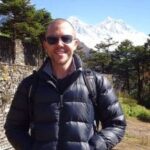
Brad Wegner
01/01/1970
Two Nights Was Awesome
I only had two nights in Kathmandu and primarily wanted to do a chopper flight around Everest as well as see as much of Kathmandu as possible. Kumar was amazing and looked after me like family. I did a lot of research and Kumar booked the Chopper flight for me and answered any and all questions I had leading up to it. The Everest day was truly one of the best and awe inspiring days of my life. Kumar also took us to all of the must see sights in Kathmandu. He listened to our needs as well as read our body language for what we required. You must have a guide in places like Kathmandu to understand the history and not miss anything and you won’t regret using Kumar – he is the best!!
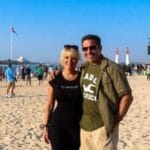
Tom And Heide
18/09/2018
AMAZING NEPAL EXPERIENCE WITH Nepal Tour Guide Team
We had the privilege exploring KTM valley with Kumar. He has a way of showing you all facets of Nepal as nobody else will. Not only does he know his country like no other, he also has a special way of connecting you with his culture , people, customs and more like a real tour guide can only do. He is a humanitarian, a good spirit, with a great sense of humor and a heart of gold, someone who CARES about his country and people. You will love the way he guides you and shows you his country. Anything from local foods, to extensive history or just small talk about politics and social issues, Kumar is happy to discuss all. He showed us a side of Nepal, we would have never experienced with a larger bus group. He customized our program to our liking, the way we wanted it, patiently answered all of our questions always friendly , attentive and genuine. We can highly recommend Kumar as your private guide. I have traveled the world extensively (please see my other reviews on tripadvisor) and know the difference between ‘just a guide’ and a true tour director who LOVES his job and connecting with people from all walks of life. Kumar is great in what he does and his personality will make you like him the day you meet. We are still friends and should we return to Nepal, there is no doubt in our minds that we will see him again, not only as our guide but also to reunite with a great friend and human being.

Two Weeks In Nepal
We came to Nepal for just under two weeks in March 2017. My husband and I decided to bring my mom for her 60th birthday as it was her lifelong dream to visit Nepal. But weren’t sure what to do while we were there! Luckily, we found Nepal Tour Guide Team, and after a few emails to Kumar, he set up the whole trip for us. Our trip was incredible, and Kumar was wonderful. From Kathmandu to Chitwan, Pokhara and back, Kumar showed us the whole country, and his knowledge was second to none. He arranged all the hotels, the car and driver, the things we did, showed us great places to eat and most importantly, provided great friendship and conversation along the way! We laughed the whole trip and had a wonderful time. The mountains were beautiful, Chitwan was amazing, and the lakeside at Pokhara was definitely my mom’s favorite part. We’re still positive we had the best tour guide and the most skilled driver in the entire country. Kumar is an incredible person and we made a lifelong friend. Even after coming home, we continue to keep in touch, chatting and making video calls. We can’t wait to go back!
Write a review
Quick enquiry
Still confused?
Talk to our expert.

Kumar Dahal
RELATED TRIPS
Sundarijal To Gosainkunda Lake Trek
Be a part of an unforgettable 11-day adventure in Nepal's most magnificent landscapes and cultural richness on the Sundarijal...
Tamang Heritage Trek
Tamang Heritage Trek is one interesting tour package that has combined some of the most breathtaking nature with the...
Langtang Kyanjin Gompa Trek
Langtang Kyanjin Gompa Trek is a trek into the memory lanes of lush valleys and towering peaks. Feel the...


